canon ae 1 camera manual
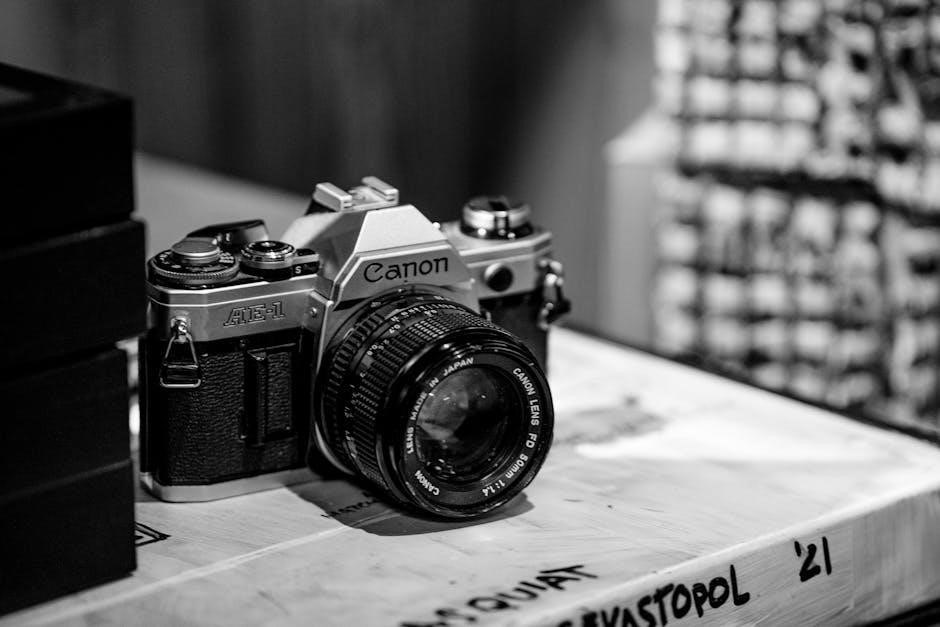
Canon AE-1 Camera Manual: Comprehensive Guide
Explore the Canon AE-1 Camera Manual for detailed insights into its features, operation, and maintenance. Discover its modes, technical specs, and troubleshooting tips to master this iconic film camera.
The Canon AE-1 is a groundbreaking 35mm single-lens reflex (SLR) film camera introduced in 1976. Known for its innovative design, it was the first camera to utilize a microprocessor for advanced exposure control, making it a landmark in photography history. Designed to appeal to both professionals and hobbyists, the AE-1 combined ease of use with manual controls, offering modes like aperture priority and manual override. Its durable build and intuitive interface made it a favorite among photographers. The camera supports Canon FD lenses, ensuring versatility in creative expression. With over 5 million units sold, the AE-1 remains a timeless classic, cherished for its reliability and functionality. This guide provides a comprehensive overview of its features, operation, and maintenance, helping users unlock its full potential. Whether you’re a seasoned photographer or a film enthusiast, the AE-1 offers unparalleled creative control and timeless appeal.
Key Features of the Canon AE-1
The Canon AE-1 boasts an array of innovative features that set it apart from its contemporaries. Its advanced Programmed AE Mode offers automatic exposure control, while the Shutter-Speed Priority Mode allows photographers to manually adjust shutter speeds for precise control over motion and lighting. The Aperture Priority Mode enables adjustments to aperture for depth of field, catering to creative needs. Additionally, a Manual Mode provides complete control over exposure settings, making it a versatile tool for various shooting scenarios. The camera is compatible with a wide range of Canon FD lenses, offering flexibility in capturing diverse subjects. Its robust design ensures durability, and the inclusion of a built-in light meter enhances accuracy in measuring exposure. These features collectively make the AE-1 a powerful and adaptable camera, suitable for both professional and amateur photographers seeking high-quality results. Its enduring popularity is a testament to its reliability and innovative design.
Understanding the Camera’s Design and Build
The Canon AE-1 features a sleek and durable design that emphasizes both functionality and user comfort. Its lightweight copper alloy body is wrapped in a rubberized grip, providing a secure hold during shooting; The camera’s black finish gives it a professional aesthetic, while its compact dimensions make it easy to carry. The viewfinder is equipped with a fixed pentaprism and a 0.8x magnification ratio, offering a bright and clear view of the scene. A microprism spot meter is also included for precise focusing. The camera’s build quality reflects the robust engineering typical of 1970s Japanese manufacturing, ensuring longevity and reliability. The AE-1 is powered by a simple battery system, with an optional motor drive available for faster shooting. Its design balances practicality and performance, making it a favorite among photographers who value both durability and creative control. The lack of plastic in its internal components further underscores its commitment to lasting quality.
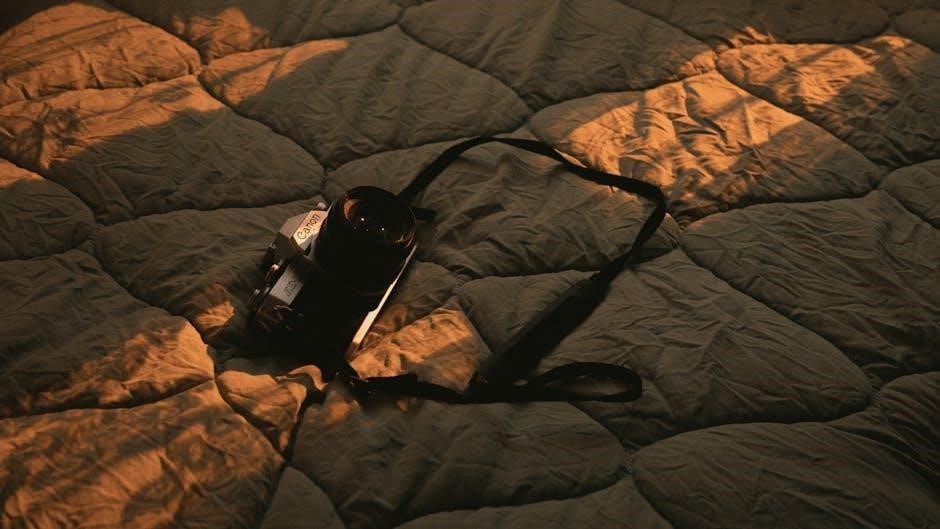
Canon AE-1 Camera Manual: Modes and Operations
The Canon AE-1 offers Programmed AE, Shutter-Speed Priority, Aperture Priority, and Manual modes. It features automatic exposure control with manual overrides, making it versatile for both beginners and professionals. The built-in microprocessor ensures precise exposure calculations, while its intuitive controls provide seamless operation. Battery-powered, it delivers reliable performance across various shooting conditions. This section details how to navigate and utilize these modes effectively for optimal results.
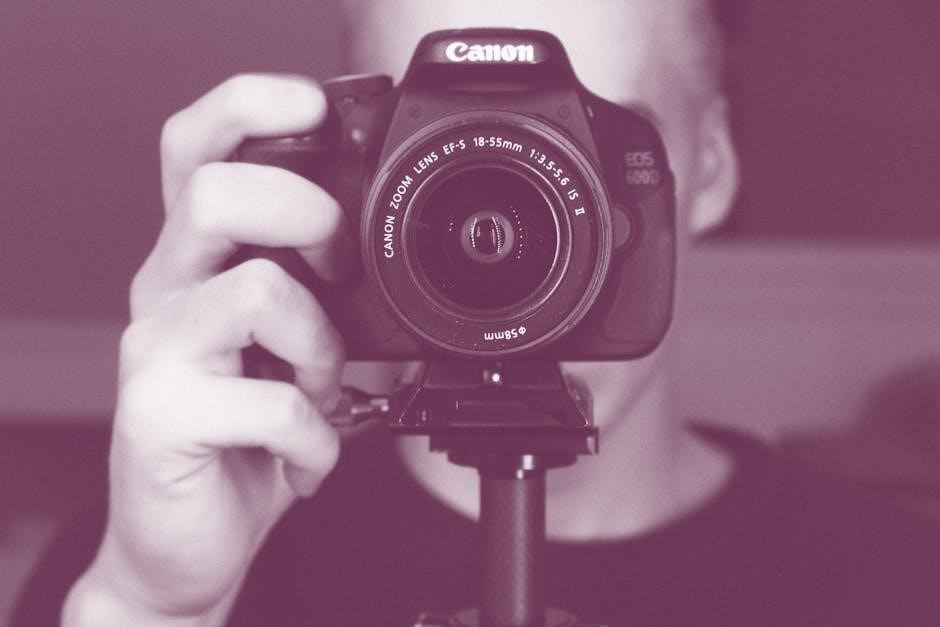
Programmed AE Mode: Automatic Exposure Control
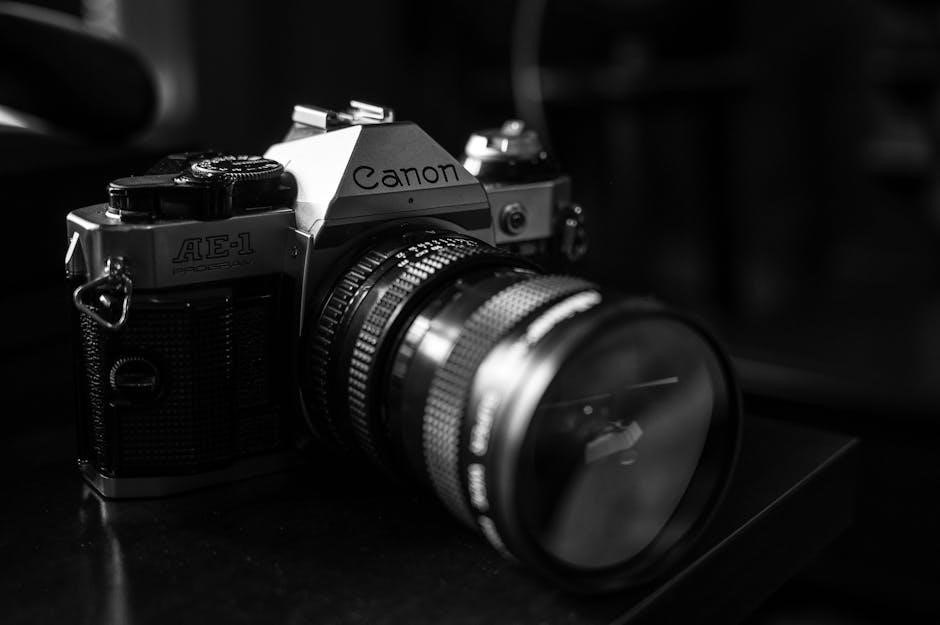
The Programmed AE Mode on the Canon AE-1 offers automatic exposure control, ideal for beginners and professionals alike. This mode allows the camera to automatically select both the aperture and shutter speed, ensuring optimal exposure in most lighting conditions. The microprocessor inside the AE-1 calculates the best settings based on the lens aperture and film speed. Users can simply compose the shot and press the shutter, making it a convenient option for quick photography. The Programmed AE Mode is particularly useful in dynamic situations where manual adjustments would be time-consuming. It provides a seamless balance between ease of use and high-quality results, making it a standout feature of the Canon AE-1. This mode is activated by setting the mode dial to the “PROGRAM” position and adjusting the aperture ring to “A.” The viewfinder will display the selected aperture and shutter speed for confirmation.
Shutter-Speed Priority Mode: Manual Control Over Shutter Speed
The Shutter-Speed Priority Mode on the Canon AE-1 allows photographers to manually set the shutter speed, giving control over motion effects. Users can choose speeds from 2 seconds to 1/1000th of a second using the shutter speed dial. The camera’s microprocessor then automatically adjusts the aperture to ensure proper exposure. This mode is ideal for freezing fast-moving subjects or creating motion blur in creative compositions. To activate it, set the mode dial to “Tv” (Time Value) and select the desired shutter speed. The aperture will be displayed in the viewfinder, and the camera will adjust it accordingly. For flash photography, the sync speed is fixed at 1/60th of a second. This mode is perfect for photographers who want precise control over shutter speed while letting the camera handle aperture adjustments, making it a versatile option for various lighting conditions and artistic effects.
Aperture Priority Mode: Adjusting Aperture for Depth of Field
The Aperture Priority Mode on the Canon AE-1 empowers photographers to manually set the aperture, allowing precise control over depth of field. By adjusting the aperture ring on the lens, users can determine how much of the image remains in focus. The camera’s microprocessor automatically sets the appropriate shutter speed to ensure correct exposure. This mode is particularly useful for portrait photography, where a wide aperture (like f/2.8) can blur the background, and for landscapes, where a narrow aperture (like f/16) keeps the entire scene sharp. The viewfinder displays the selected aperture and the corresponding shutter speed, making it easy to monitor settings. Additionally, the depth of field preview button enables a real-time review of focus effects. This mode is ideal for photographers seeking creative control over depth of field while letting the camera handle exposure calculations, ensuring both technical precision and artistic expression.
Depth of field preview allows real-time focus effect review, enhancing compositional accuracy. The AE-1’s intuitive design makes aperture adjustments seamless, ensuring quick access to desired effects. Whether capturing sharp landscapes or soft backgrounds, this mode delivers exceptional flexibility and control.
Manual Mode: Complete Control Over Exposure Settings
In Manual Mode, the Canon AE-1 offers full control over exposure settings, allowing photographers to independently adjust both aperture and shutter speed. This mode is ideal for experienced users who prefer precise control over their images. To use Manual Mode, photographers set the desired aperture using the lens aperture ring and the shutter speed via the camera’s dial. The built-in metering system provides a light meter in the viewfinder, indicating whether the selected settings will result in proper exposure. The meter’s needle points to the recommended aperture or shutter speed, while the LEDs indicate overexposure or underexposure; This mode is particularly useful in complex lighting conditions where automatic modes may not produce the desired results. Photographers can also use the depth of field preview button to review focus effects before shooting. Manual Mode requires a working battery to power the metering system, ensuring accurate exposures. For advanced photographers, this mode offers unparalleled creative freedom, allowing for precise control over every aspect of exposure.
By mastering Manual Mode, photographers can achieve their vision with the AE-1, making it a powerful tool for artistic expression.
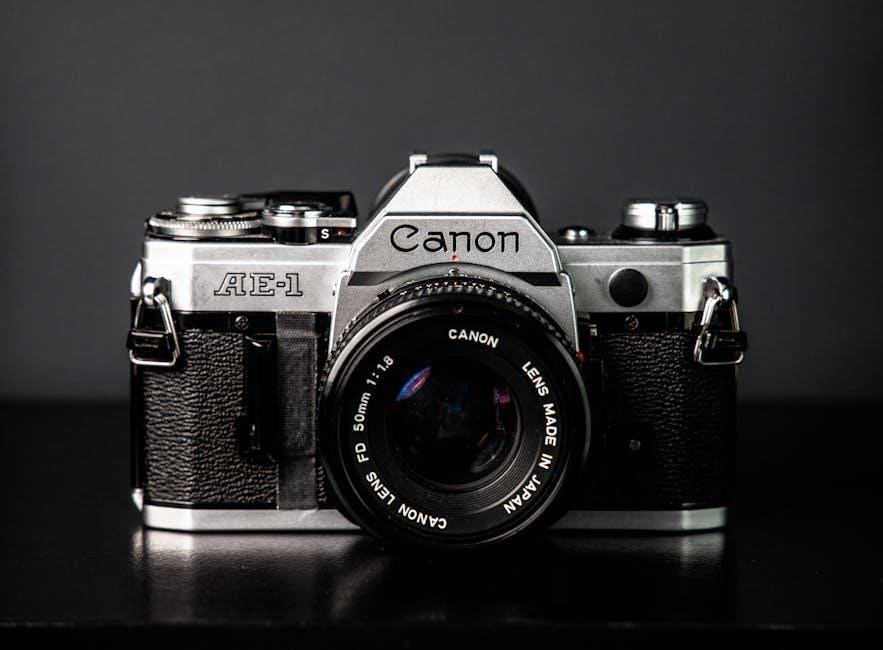
Canon AE-1 Camera Manual: Technical Specifications
The Canon AE-1 is a 35mm SLR film camera, compatible with FD and non-FD lenses. It features a shutter speed range of 2-1/1000th of a second, flash sync at 1/60th, and a built-in center-weighted metering system for accurate exposures. The camera’s durable design and precise engineering make it a reliable choice for photographers. Its technical specs ensure versatility and performance, catering to both casual and professional use. The AE-1’s specifications highlight its enduring appeal as a classic film camera.
With its robust build and advanced features for its time, the AE-1 remains a favorite among photography enthusiasts. Its technical capabilities continue to inspire creative photography.
Lens Compatibility: FD and Non-FD Lenses
The Canon AE-1 is designed to work seamlessly with Canon FD-mount lenses, offering precise control and compatibility; FD lenses feature a unique aperture control system, enabling smooth adjustments for exposure. Non-FD lenses can also be used, but they require manual stop-down metering to ensure accurate exposure readings. The camera’s lens compatibility provides flexibility for photographers, allowing the use of a wide range of lenses to suit different shooting needs.
When using FD lenses, the camera automatically adjusts the aperture for optimal results. For non-FD lenses, users must manually set the aperture and use the depth-of-field preview button to measure light accurately. This dual compatibility makes the AE-1 versatile for both modern and vintage photography applications. The ability to adapt to various lenses enhances the camera’s functionality and creative potential.
Shutter Speed Range and Flash Sync
The Canon AE-1 boasts an impressive shutter speed range of 1/1000th of a second to 30 seconds, plus a bulb (B) mode for extended exposures. This versatility allows photographers to capture a wide variety of scenes, from freezing fast-moving subjects to creating artistic long exposures. The camera also features a flash synchronization setting at 1/60th of a second, enabling seamless integration with external flash units for well-balanced lighting in challenging conditions.
The AE-1’s electronic flash system is designed to work harmoniously with the camera’s aperture priority mode, ensuring optimal flash exposure. Whether shooting in low-light environments or adding a creative touch with flash, the AE-1 delivers consistent results. This combination of shutter speed flexibility and reliable flash sync makes it a powerful tool for both amateur and professional photographers seeking precision and control over their images.
Viewfinder and Metering System
The Canon AE-1 features a bright and clear viewfinder with a fixed pentaprism, providing 95% coverage of the actual image area. This ensures accurate composition and framing. The viewfinder also includes a built-in microprism spot meter and matching needles for easy exposure adjustments.
The camera’s metering system is a center-weighted average type, designed to provide accurate exposures by measuring light from the entire frame, with emphasis on the central area. This system works seamlessly with the AE-1’s aperture priority and manual modes, allowing for precise control over lighting conditions. The metering system is powered by a 6V silver oxide battery, ensuring reliable operation.
With its intuitive viewfinder and advanced metering capabilities, the AE-1 empowers photographers to achieve professional-quality results effortlessly.
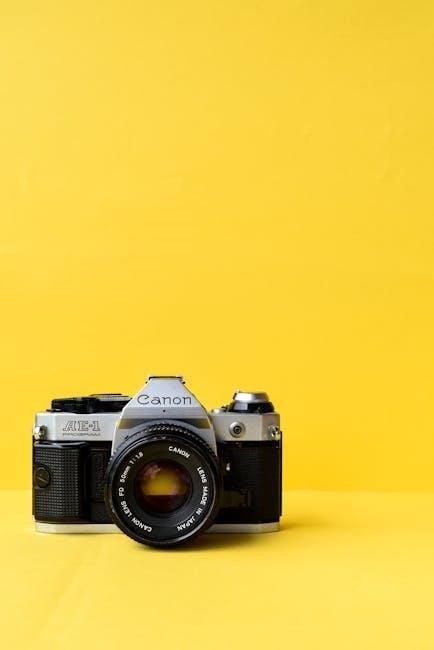
Canon AE-1 Camera Manual: Maintenance and Care
Regular cleaning of the camera and lens prevents dust buildup. Store the camera in a cool, dry place to maintain functionality. Proper care ensures longevity and optimal performance.
Cleaning the Camera and Lens
To maintain your Canon AE-1’s performance, regular cleaning is essential. Start by using compressed air to gently remove dust from the camera body and lens. For the lens, use a soft, lint-free cloth or specialized lens tissues with a few drops of lens cleaning solution. Avoid touching the lens surface to prevent smudges. Clean the viewfinder with a soft cloth to ensure clear visibility. For the mirror, use a dry, lint-free cloth or a cleaning solution specifically designed for camera mirrors. Never use household cleaners or abrasive materials, as they can damage the camera’s finish or lens coating. Store the camera in a dry environment to prevent moisture buildup; Regular maintenance will help preserve the functionality and longevity of your Canon AE-1.
Battery Maintenance and Power Management
Proper battery maintenance is crucial for the Canon AE-1’s operation. The camera uses a 4LR44 or equivalent battery, which powers the metering system and electronic controls. To ensure optimal performance, always use fresh batteries and avoid mixing old and new ones. Check the battery expiration date before installation. If the battery compartment becomes dirty, clean it with a dry cloth to maintain good contact. Store batteries in a cool, dry place, away from metal objects to prevent drainage. For extended periods of non-use, remove the battery to prevent leakage. Use a multimeter to verify battery voltage (4.5V for 4LR44). Avoid extreme temperatures, as they can reduce battery life. For heavy use, consider the optional Canon Power Winder A, which simplifies shooting and reduces manual winding. Always turn off the meter when not in use to conserve power, ensuring the AE-1 remains reliable for years of photography.
Storage and Transport Tips
Proper storage and transport of your Canon AE-1 are essential to maintain its functionality and longevity. Store the camera in a dry, cool place away from direct sunlight and humidity. Use a protective case or bag to shield it from dust and accidental damage. When not in use for extended periods, ensure the camera is clean and free of moisture. Consider placing silica gel packets in the storage area to absorb any residual humidity. For transport, always secure the camera in a padded case or bag, ensuring the lens is protected. Avoid stacking heavy items on top of the camera or exposing it to extreme temperatures. Before storing or transporting, remove the battery to prevent corrosion. For added protection, use the original Canon lens caps and consider adding a protective filter. Regularly inspect the camera and accessories for signs of wear or damage during transport. Proper handling ensures your AE-1 remains in excellent condition for years of use.
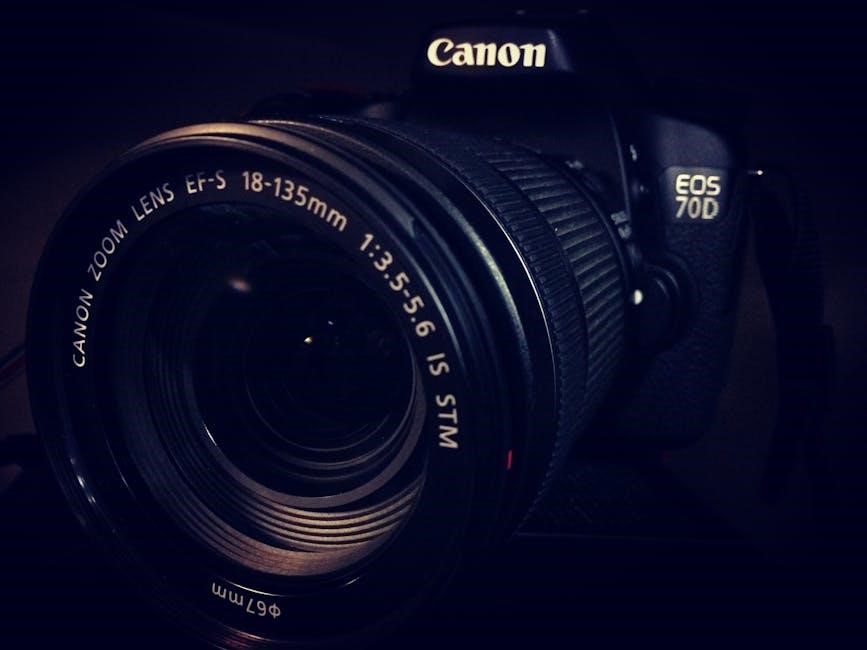
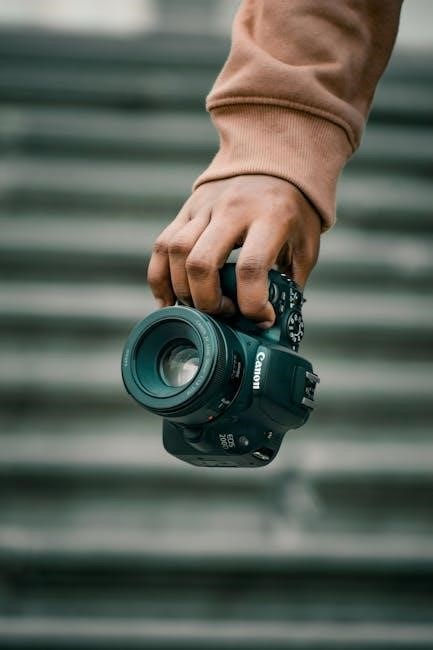
Canon AE-1 Camera Manual: Troubleshooting Common Issues

Address common issues like shutter malfunctions or exposure errors by consulting the troubleshooting section. It provides solutions for error correction and guidance on maintaining optimal camera performance and reliability.
Common Errors and Solutions
The Canon AE-1 is a reliable camera, but like any device, it can experience issues. Common errors include shutter malfunctions, exposure inaccuracies, and battery drain. For shutter issues, ensure the battery is fresh and the shutter is not stuck due to dirt. Cleaning the shutter mechanism gently with a soft brush can resolve this. Exposure problems often arise from incorrect aperture or shutter speed settings; refer to the manual to ensure proper configuration. Battery drain can be prevented by using high-quality batteries and avoiding prolonged use of the meter. If the viewfinder is foggy, clean it with a microfiber cloth. For persistent issues, consult the troubleshooting guide or contact a professional. Regular maintenance and proper storage can prevent many of these errors, ensuring your Canon AE-1 operates smoothly;
Repair and Service Options
For the Canon AE-1, repair and service options are available to ensure optimal performance. Minor issues like jammed shutters or faulty meters can often be resolved with DIY cleaning or replacement of worn parts. Professional servicing is recommended for complex problems, such as internal mechanical failures or electrical malfunctions. Certified camera repair shops specialize in vintage models like the AE-1 and can restore functionality. Additionally, online communities and forums provide extensive repair guides and resources, including downloadable service manuals. The Canon AE-1 Service Manual (available at http://www.baytan.org/prak/pdf/serv/AE-1serv-rep.pdf) offers detailed instructions for advanced repairs; Regular maintenance and proper handling can prevent many issues, but when professional intervention is needed, these resources ensure your Canon AE-1 remains operational for years to come.
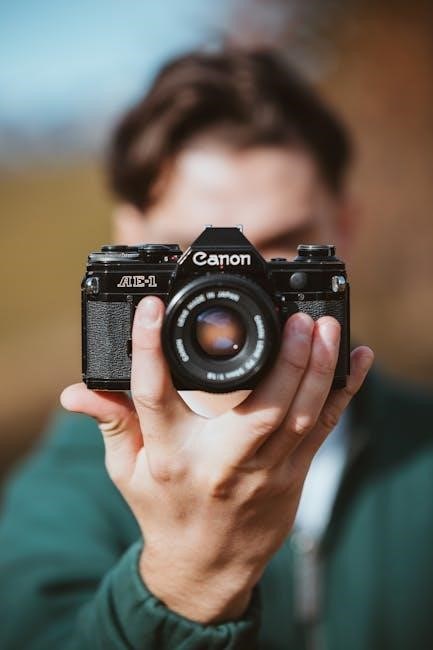
Canon AE-1 Camera Manual: Additional Resources
Download the Canon AE-1 Manual from trusted sources like Butkus or the Baytan service manual for detailed repair guides and specifications. Explore online forums and communities for additional tips and resources.
Downloading the Canon AE-1 Manual
The Canon AE-1 Manual is widely available online in PDF format, offering detailed instructions for operating and maintaining the camera. Websites like Butkus and Baytan provide free downloads of the manual, ensuring easy access for users. The manual covers features, shooting modes, and technical specifications, making it an essential resource for both beginners and experienced photographers. It also includes troubleshooting guides and maintenance tips to keep the camera in optimal condition. For those seeking additional information, online forums and communities often share user-generated guides and repair manuals. Downloading the manual is a great way to deepen your understanding of the Canon AE-1 and unlock its full potential. Ensure you verify the source for authenticity to avoid outdated or incorrect versions.
Online Communities and Repair Guides
Online communities and forums are invaluable resources for Canon AE-1 users, offering repair guides, troubleshooting tips, and user experiences. Platforms like Flickr groups and specialized photography forums provide spaces for discussions and sharing knowledge. Websites such as Butkus and Baytan host comprehensive repair manuals and service guides, which are essential for DIY maintenance and fixing common issues. These resources not only help in resolving technical problems but also foster a sense of community among Canon AE-1 enthusiasts. By engaging with these online resources, users can enhance their skills and ensure their camera remains in excellent working condition. These guides are particularly useful for those who prefer hands-on repair and want to keep their vintage camera functional for years to come.